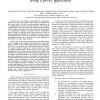Free Online Productivity Tools
i2Speak
i2Symbol
i2OCR
iTex2Img
iWeb2Print
iWeb2Shot
i2Type
iPdf2Split
iPdf2Merge
i2Bopomofo
i2Arabic
i2Style
i2Image
i2PDF
iLatex2Rtf
Sci2ools
SBACPAD
2015
IEEE
2015
IEEE
Progressive Codesign of an Architecture and Compiler Using a Proxy Application
Abstract—The Active Memory Cube (AMC) is a novel nearmemory processor that exploits high memory bandwidth and low latency close to DRAM to execute scientific applications in an energy-efficient manner. Its energy efficiency is derived from a combination of its novel scalar-vector data-flow path combined with its simple control-flow path that required the development of a sophisticated compiler, co-designed with the architecture. Such co-design is commonly done using hand-tuned codes for simple kernels that typically do not capture the nuances of realworld applications or reveal the complexities of programming a heterogeneous system. At the same time, an entire application is intractable to an early-stage compiler. In this work we describe a progressive, iterative methodology to the co-design of the compiler and architecture for the AMC using LULESH, a real-world hydrodynamics proxy application. We focus on a procedure that calculates the kinematic variables for domain elements. ...
Hardware | SBACPAD 2015 |
| Added | 17 Apr 2016 |
| Updated | 17 Apr 2016 |
| Type | Journal |
| Year | 2015 |
| Where | SBACPAD |
| Authors | Arpith C. Jacob, Ravi Nair, Tong Chen, Zehra Sura, Changhoan Kim, Carlo Bertolli, Samuel Antão, Kevin O'Brien |
Comments (0)

